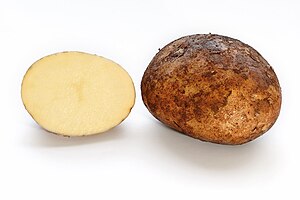Potato
Description
editGrowing Conditions
editReducing the ground until completely free from root-weeds helps in potato husbandry; though in many seasons one cannot complete these operations without losing the proper time for planting, which never ought to come after the first of May, if circumstances do not absolutely prevent it.
Cutting the seed into small slips does not provide any advantage, for the strength of the stem at the outset depends in direct proportion upon the vigor and power of the seed-plant. Accordingly, make the seed plant large, rarely smaller than the fourth-part of the potato; and in the case of small seed-potatoes one may profitably use half of the potato. At all events, rather err in using over-large seed than in making it too small; because, by the first error, no great loss can ever be sustained; whereas, by the other, a feeble and late crop may result. With properly cut seed, it requires from ten to twelve hundredweight of potatoes to plant an acre (1.2 to 1.5 t/ha) of ground, where the rows lie twenty-seven inches (700 mm) apart; but this quantity depends greatly upon the size of the potatoes used; large potatoes may require a greater weight, but the extra quantity will abundantly pay off in the superiority of the crop which large seed usually produces.
Cultivation should go twelve inches deep, if the soil will allow it; after this, the gardener should open a hole (about six inches (150 mm) deep and not more than twelve inches (300 mm) in diameter).
There are two common alternate methods of growing potatoes by the amateur gardener. The first is container growing. One seed potato should be placed 15cm (6in) deep in a container which is 30cm (1ft) or more in diameter. Normal potting compost can be used. The amount of potatoes will obviously be small, but it's fun for the small garden.
The second method is to cover the planting area for early varieties with black polythene, simply held down with earth or bricks. The potatoes are planted at normal depth by cutting a '+' shaped hole in the plastic and planting with a trowel. The advantages are that the soil is warmed by the black polythene, giving the young plants protection from frost. The potatoes should be ready for harvest a couple of weeks earlier than normal.
Varieties
editUses
editMaintenance
editPropagation
editHarvest
editPotatoes are ready for harvest when the foliage first starts to die and turn yellow. Early (new) potatoes can be lifted earlier (no earlier than June) to get the very tastiest potatoes. In this case, harvest them about a week after the potato plant flowers first appear. New potatoes only produce a couple of handfuls of potatoes per plant, so dig up the whole plant.
Maincrop potatoes will be ready for harvest in mid-Autumn (start of September at the earliest). For all potatoes, dig them up from the side of the ridge (a fork or spade are both fine) to avoid damaging the potatoes. The foliage can be placed on the compost heap only if it completely free from disease - if not, burn it. If you don't need all the potatoes from a plant at one time or if you want a few early in the season, simply burrow around the roots with your hands and remove the potatoes you need. The remaining potatoes will continue to grow.
Remove any soil clinging to the potatoes and leave them on the soil for a few hours to dry out - if they are stored damp, they will rot. Leaving them on the soil surface in the sun will harden the skin slightly, doubling the storage time - this is especially important for maincrop potatoes. Store the potatoes in boxes or sacks, checking them every few days, removing all but those in good condition. Damaged or blemished potatoes should be eaten immediately.
One word of caution, some potato flowers may well turn to berries which are definitely poisonous. Eaten in sufficient amounts the berries can be fatal. You may wish to remove them if children are likely to see them.
Store up potatoes for winter and spring use; and as one should keep them as long through summer as possible, make every endeavor to preserve them from frost, and from sprouting in the spring months. For frost protection, cover them well with straw when lodged in a house, and by a thick coat of earth when deposited in a pit; to prevent sprouting, pick them carefully at different times, when they begin to sprout, and dry them sufficiently by exposure to the sun, or by a gentle toast of a kiln.
Pests and Diseases
editPotatoes grown from stock certified as free from disease and planted in soil not occupied by potatoes the previous season, are relatively free from pests and diseases. The most common ailments to affect potatoes are potato blight (see next paragraph), scab, slugs, and wireworm. There is little protection available that can effectively solve these problems.
Potato blight has two phases - the first attacks the leaves, the second attacks the potatoes themselves. If your potatoes are attacked by the blight, there is no cure. However, cut the foliage back to 5cm (2in) from the ground at the first signs of infection. This will prevent the blight from getting to the potatoes themselves. With no foliage, the potatoes will not give of their best, but they will continue to grow for a month or so.
References
edit
